North America Contract Logistics Market Size
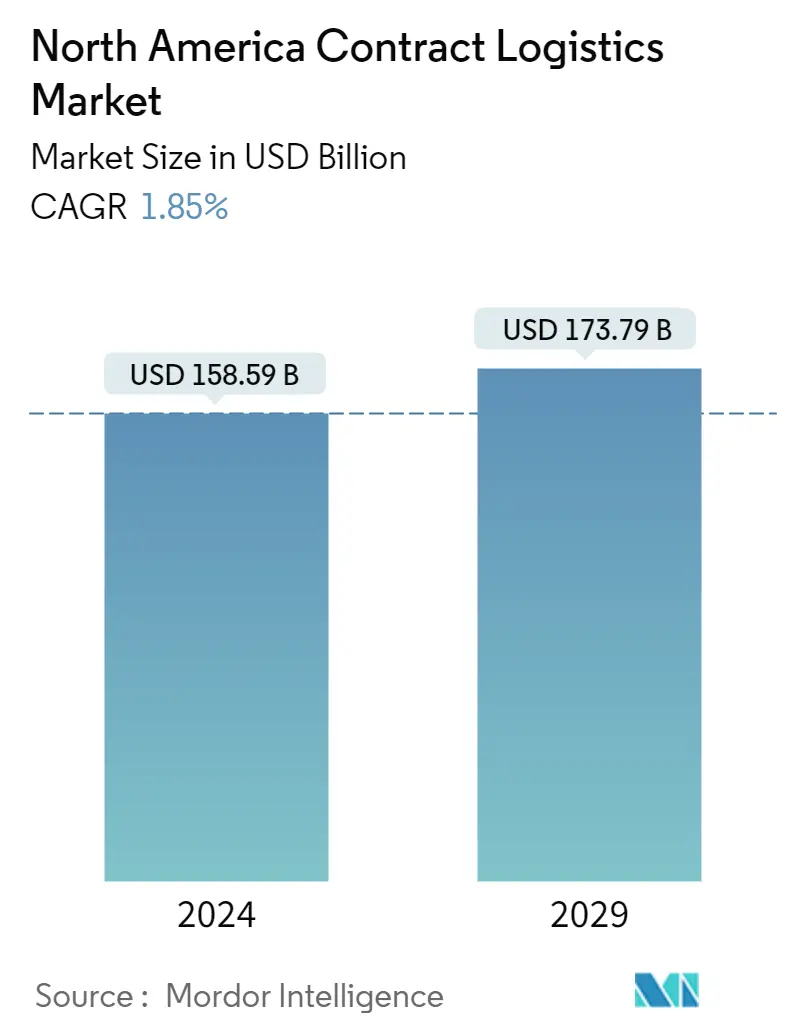
| Study Period | 2020 - 2029 |
| Base Year For Estimation | 2023 |
| Market Size (2024) | USD 158.59 Billion |
| Market Size (2029) | USD 173.79 Billion |
| CAGR (2024 - 2029) | 1.85 % |
| Market Concentration | Low |
Major Players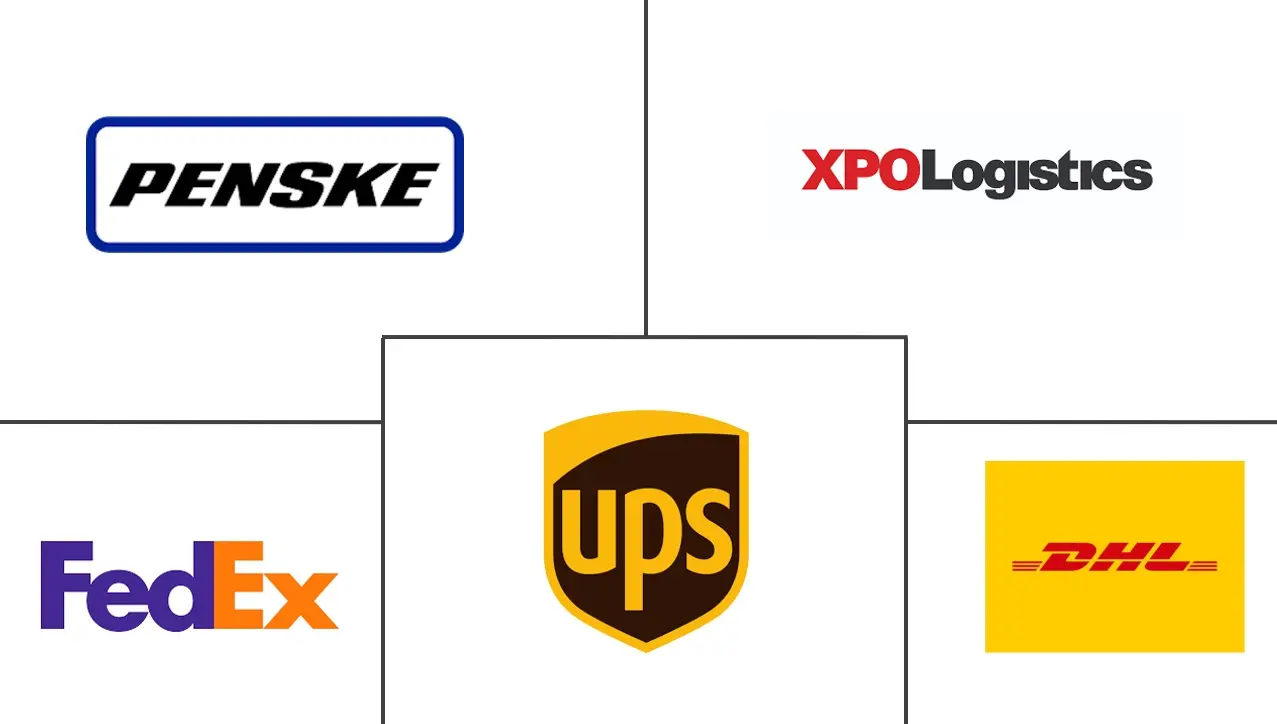
*Disclaimer: Major Players sorted in no particular order |
Need a report that reflects how COVID-19 has impacted this market and its growth?
North America Contract Logistics Market Analysis
The North America Contract Logistics Market size is estimated at USD 158.59 billion in 2024, and is expected to reach USD 173.79 billion by 2029, growing at a CAGR of 1.85% during the forecast period (2024-2029).
- Infrastructure development, digitization, and industrialization are all results of increasing government initiatives for economic diversification. They will probably expand the e-commerce and contract logistics markets, creating a big need for contract logistics services. Several non-asset newcomers are joining current companies as a result of the increase in foreign direct investments (FDIs), the rapid expansion of the e-commerce industry, and the emphasis on risk management in supply chains.
- Additional factors that contribute to market expansion include the manufacturing sector's quick expansion and focus on core competencies, the rising demand for work optimization, achieving cost efficiency, and technological supply chain integrations. The contract logistics industry will not develop because of some constraints and challenges. For instance, managing logistical databases is difficult due to factors including potential misconceptions that lead to inaccurate interpretations of facts, data, and information. Regional disparities and the complexity of the supply chain have a detrimental impact on the process as a whole since there aren't enough experienced people to understand and address problems so that transparency is maintained.
- In 2022, the United States saw a sharp rise in warehouse space rental from regional logistics players in recent years. Retailers are increasingly outsourcing more of their services as a result of rising service requirements like e-commerce and same-day delivery.
- The pandemic's impact on global supply chains put the United States' whole supply chain under unprecedented pressure and exposed long-standing issues with its freight transportation system. Delays and a highly unbalanced flow of products to American ports were caused by interruptions in manufacturing and port closures. More inbound freight arrived at ports as a result of cargo owners switching to "just-incase" inventory plans rather than "just-in-time" methods, which put a strain on storage capacity. The system experienced a significant boost in flow as a result, with each of America's four largest container ports exceeding their prior records and importing over 16% more containers in 2021 than in 2020.
North America Contract Logistics Market Trends
This section covers the major market trends shaping the North America Contract Logistics Market according to our research experts:
Growing E-commerce in the Region Driving the Contract Logistics Market
The estimate of US retail e-commerce sales for the third quarter of 2022, adjusted for seasonal variation but not for price adjustments, was USD 265.9 billion, up by 3.0% (0.5%) from the second quarter of 2022, according to a report released by the Census Bureau of the Department of Commerce. The predicted USD 1,792.0 billion in total retail sales for the third quarter of 2022 represents an increase of 0.7% (0.1%) from the second quarter. While total retail sales climbed 9.1% (minus 0.4%) during the same period, the third quarter of 2022 e-commerce projection increased by 10.8% (minus 1.2%) from the third quarter of 2021. In the third quarter of 2022, e-commerce sales made up 14.8% of total sales.
Canada has the fastest-growing e-commerce market among the three countries in the area, while the US has the largest and steadiest-growing market. In Mexico, e-commerce user penetration is not very high. However, throughout the projected period, the Mexican e-commerce market is anticipated to rise strongly.
Over 27 million Canadians used e-commerce in 2021, making up 72.5% of the country's total population. In 2025, this percentage is projected to rise to 77.6%. Retail e-commerce sales in Canada are rising steadily in real terms and as a share of overall retail, thanks to a rise in online shoppers. The United States, ahead of China and Japan, was the second-largest e-commerce market in terms of revenue in 2021. In the upcoming years, e-commerce sales may continue to rise. The percentage of e-commerce in all US retail online sales is 13.3%.
Most e-commerce businesses award warehouse and distribution service contracts to logistics service providers. Businesses need to have technical solutions that quicken fulfillment operations because of the high-velocity e-commerce business models.
Startups in the fields of on-demand and cloud-based warehousing are becoming more and more well-known as e-commerce takes off. As opposed to long-term leases for a set space, these businesses give businesses the freedom to use the warehouse space by seasonal demand. These businesses include Stord, Flexe, and Flowspace, to name a few. Long-term projects are also given to these businesses by their clients. Some businesses also provide fulfillment services, giving the current standard contract logistics service providers fierce competition.
Traditional commercial real estate firms also make technology investments. For instance, ProLogis, the industry leader in logistics real estate, offers a venture fund devoted to financing innovations in contract logistics.
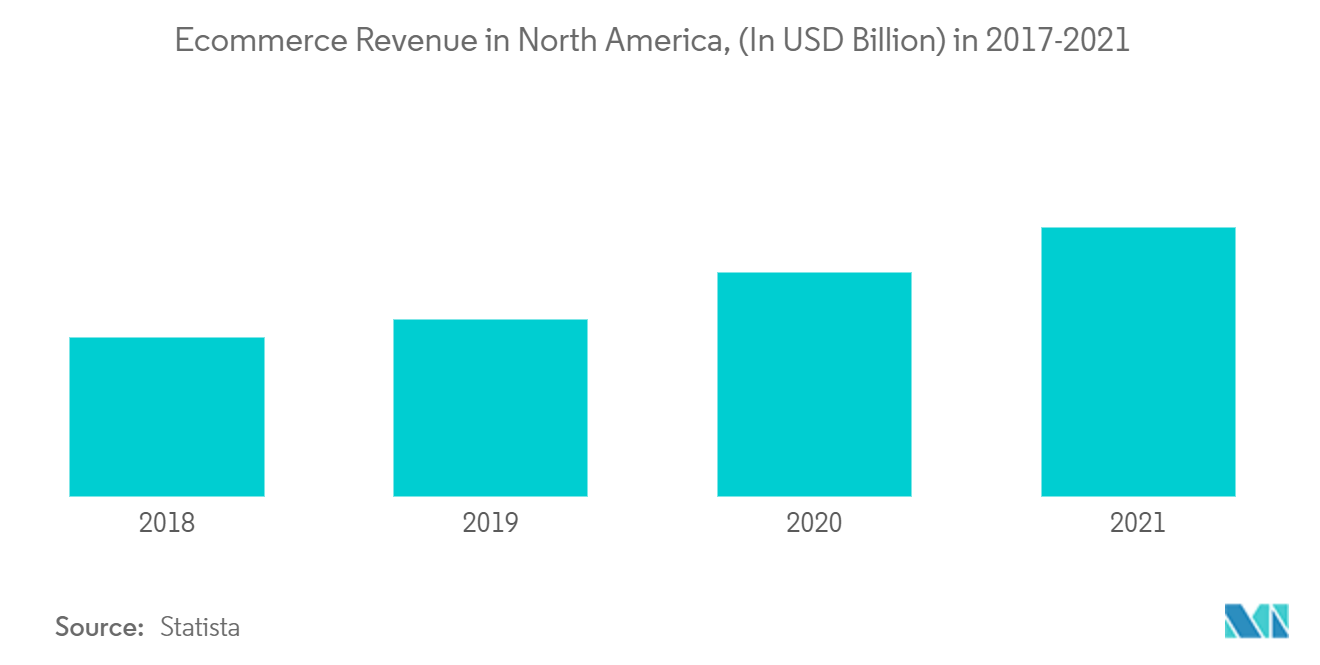
Manufacturing and Automotive Expected to Witness High Growth During the Forecast Period
Manufacturing businesses spend a lot of time trying to come up with new and inventive ways to outperform the competition, whether it is by developing new manufacturing techniques, better products, or better supply chain management.
Effective routing management is the crux of logistics for the manufacturing sector. To cut the cost of sending goods to the vendors, logistic providers help with bills of lading and freight planning. Manufacturers who outsource their logistical needs avoid the payroll, benefit, and liability costs associated with hiring in-house workers, in addition to saving money on shipping.
The pandemic's impact on US manufacturing in 2022 will be beneficial. Due to the introduction of vaccines and increasing demand, the recovery gathered steam in 2021, and by the middle of the year, industrial production and capacity utilization were higher than they were before the pandemic. Strong rises in new orders across all key subsectors could spur further expansion in 2022. Manufacturing GDP growth in the United States is predicted to reach 4.1% in 2022, according to industry sources. In Canada, lockdowns were loosened, which resulted in a rise in manufacturing activity in 2021.
The COVID-19 pandemic, continuous cost volatility, policy decisions, and industry disruption risk continue to be factors for the manufacturing sector. There is pressure on US industries to start producing essential commodities domestically and rely less on European and Asian nations as a result of the pandemic-related shortages.
Most of the management of the North American automotive supply chain is done by logistics businesses. The majority of the engines and gearboxes used in Mexican automobile manufacturing are imported from the United States.
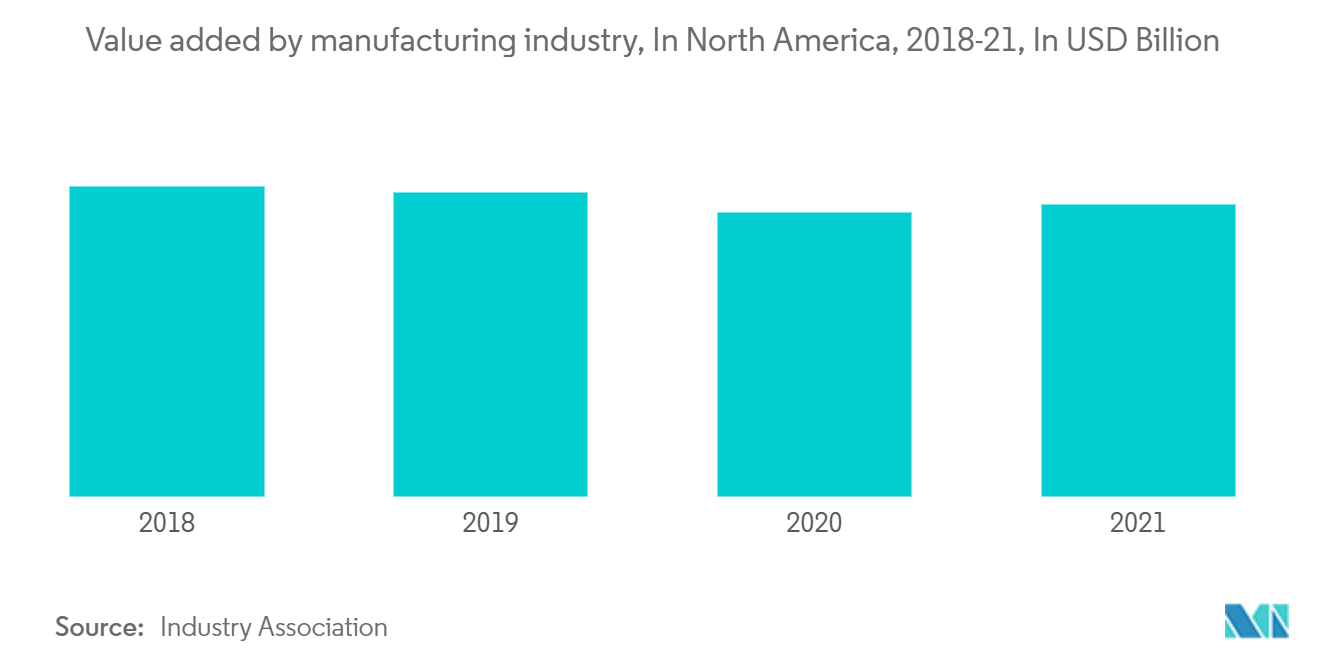
North America Contract Logistics Industry Overview
The North American contract logistics business is fragmented, with many different players competing for customers and offering services at different price points. Some of the major participants in the market are DHL, XPO Logistics, UPS, FedEx, DB Schenker, and Ryder Systems. To establish a presence in the market, the businesses are following the trends of consolidation and expansion.
North America Contract Logistics Market Leaders
Deutsche Post DHL Group (DHL Supply Chain)
United Parcel Service Inc. (UPS Supply Chain Solutions)
FedEx Corporation (FedEx Supply Chain)
XPO Logistics Inc.
Penske Logistics Inc.
*Disclaimer: Major Players sorted in no particular order
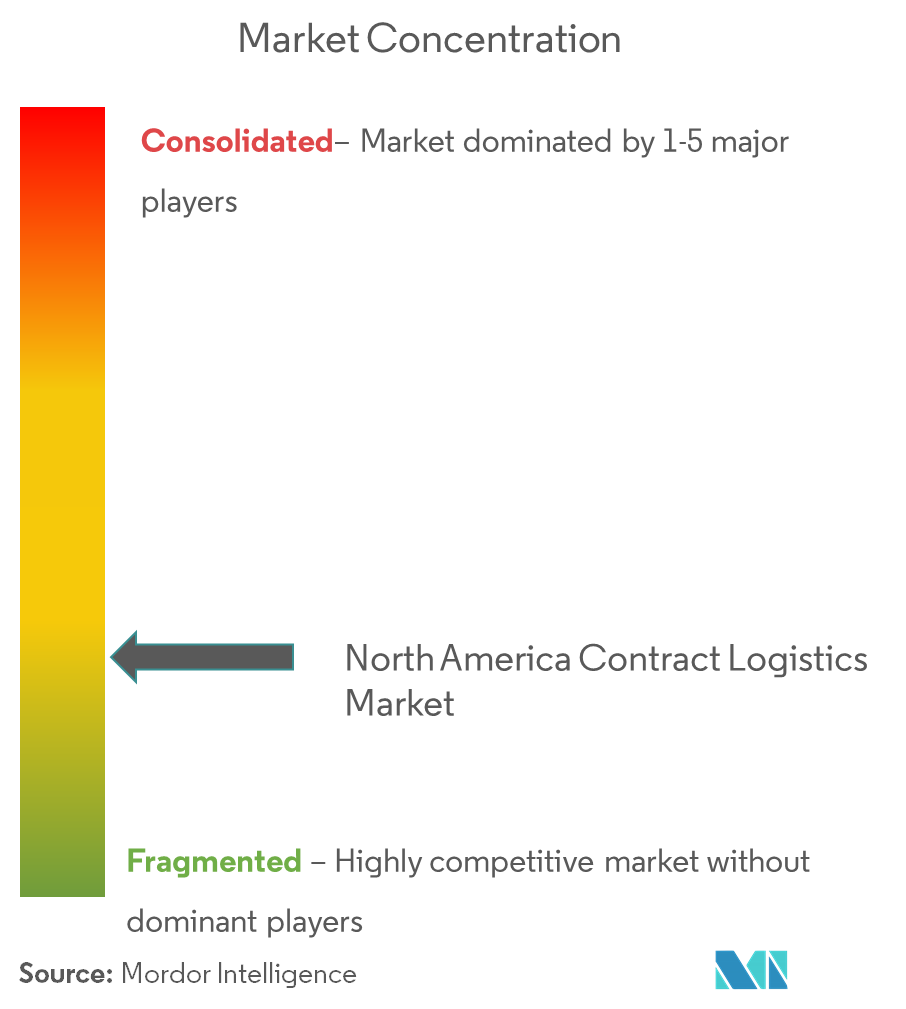
North America Contract Logistics Market News
- Jun 2022: DHL Supply Chain, in contract logistics in the Americas and a division of Deutsche Post DHL Group, revealed that LocusBots from Locus Robotics had selected more than 100 million units in its North American facilities. The achievement was made at the DHL facility in Hanover Township, Pennsylvania, while completing orders for a significant clothes retailer. The facility where the milestone was reached is one of over a dozen DHL locations in North America that employ more than 2,000 LocusBots-more than any other contract logistics provider.
- Feb 2022: The Life Sciences and Healthcare (LSHC) sector of Deutsche Post DHL Group announced that it would invest upwards of USD 400 million to increase the footprint of its pharmaceutical and medical device distribution network by 27% this year, or nearly 3 million additional square feet. DHL Supply Chain is the industry leader in global and North American contract logistics. DHL Supply Chain's latest investment comprises six additional US sites by the end of 2022 with the ultimate goal of bringing essential healthcare supplies closer to business partners and patients. The investment covers the costs of fitting out and launching new or enlarged activities, as well as investing in new structures and technologies.
North America Contract Logistics Market Report - Table of Contents
1. INTRODUCTION
1.1 Study Deliverables
1.2 Study Assumptions
1.3 Scope of the Study
2. RESEARCH METHODOLOGY
2.1 Analysis Methodology
2.2 Research Phases
3. EXECUTIVE SUMMARY
4. MARKET DYNAMICS AND INSIGHTS
4.1 Current Market Scenario
4.2 Market Dynamics
4.2.1 Drivers
4.2.2 Restraints
4.2.3 Opportunities
4.3 Industry Attractiveness - Porter's Five Forces Analysis
4.4 Value Chain/Supply Chain Analysis
4.5 Government Regulations and Initiatives
4.6 Technological Trends
4.7 Insights into the E-commerce Industry in the Region (Domestic and Cross-border)
4.8 Insights into Contract Logistics in the Context of After-Sales/Reverse Logistics
4.9 Brief on Different Services Provided by Contract Logistics Players (Integrated Warehousing and Transportation, Supply Chain Services, and Other Value-added Services)
4.10 Spotlight - Freight Transportation Costs/Freight Rates
4.11 Effect of the Shift from NAFTA to USMCA on the Transport and Logistics Industry
4.12 Impact of COVID-19 on the Contract Logistics Market
5. MARKET SEGMENTATION
5.1 By Type
5.1.1 Insourced
5.1.2 Outsourced
5.2 By End User
5.2.1 Manufacturing and Automotive
5.2.2 Consumer Goods and Retail
5.2.3 High-tech
5.2.4 Healthcare and Pharmaceuticals
5.2.5 Other End Users
5.3 By Country
5.3.1 United States
5.3.2 Canada
5.3.3 Mexico
6. COMPETITIVE LANDSCAPE
6.1 Overview (Market Concentration, Major Players)
6.2 Company Profiles (Mergers, Acquisitions, Joint Ventures, Collaborations, and Agreements)
6.2.1 Deutsche Post DHL Group (DHL Supply Chain)
6.2.2 United Parcel Service Inc. (UPS Supply Chain Solutions)
6.2.3 FedEx Corporation (FedEx Supply Chain)
6.2.4 Kuehne + Nagel International AG
6.2.5 XPO Logistics Inc.
6.2.6 Ryder System Inc.
6.2.7 J.B. Hunt Transport Services Inc.
6.2.8 DB Schenker
6.2.9 CEVA Logistics
6.2.10 Geodis
6.2.11 Penske Logistics Inc.
6.2.12 Hellmann Worldwide Logistics GmbH & Co. KG
6.2.13 Americold
6.2.14 Schnedier National*
6.3 Other Companies (Key Information/Overview)
6.3.1 Neovia Logistics Services LLC
6.3.2 TIBA
6.3.3 Yusen Logistics Co. Ltd
6.3.4 PiVAL International
6.3.5 SCI*
7. MARKET OPPORTUNITIES AND FUTURE TRENDS
8. APPENDIX
8.1 GDP Distribution, by Activity for Key Countries
8.2 Insights into Capital Flows
8.3 External Trade Statistics - Export and Import, by Product
8.4 Insights into Key Export Destinations
8.5 Insights into Key Import Origins
North America Contract Logistics Industry Segmentation
Contract logistics is a long-term partnership that covers various services, from shipping goods or replacement parts to delivering final goods to customers. Every stage of distribution and final delivery is handled by the logistics contract's provider.
The North American Contract Logistics Market is segmented by Type (Outsourced and Insourced), End User (Manufacturing and Automotive, Consumer Goods and Retail, High-Tech, Healthcare and Pharmaceuticals, and Other End Users), and Country. The report offers market size and forecasts in Values (USD billion) for all the above segments.
| By Type | |
| Insourced | |
| Outsourced |
| By End User | |
| Manufacturing and Automotive | |
| Consumer Goods and Retail | |
| High-tech | |
| Healthcare and Pharmaceuticals | |
| Other End Users |
| By Country | |
| United States | |
| Canada | |
| Mexico |
North America Contract Logistics Market Research FAQs
How big is the North America Contract Logistics Market?
The North America Contract Logistics Market size is expected to reach USD 158.59 billion in 2024 and grow at a CAGR of 1.85% to reach USD 173.79 billion by 2029.
What is the current North America Contract Logistics Market size?
In 2024, the North America Contract Logistics Market size is expected to reach USD 158.59 billion.
Who are the key players in North America Contract Logistics Market?
Deutsche Post DHL Group (DHL Supply Chain), United Parcel Service Inc. (UPS Supply Chain Solutions), FedEx Corporation (FedEx Supply Chain), XPO Logistics Inc. and Penske Logistics Inc. are the major companies operating in the North America Contract Logistics Market.
What years does this North America Contract Logistics Market cover, and what was the market size in 2023?
In 2023, the North America Contract Logistics Market size was estimated at USD 155.71 billion. The report covers the North America Contract Logistics Market historical market size for years: 2020, 2021, 2022 and 2023. The report also forecasts the North America Contract Logistics Market size for years: 2024, 2025, 2026, 2027, 2028 and 2029.
North America Contract Logistics Industry Report
Statistics for the 2024 North America Contract Logistics market share, size and revenue growth rate, created by Mordor Intelligence™ Industry Reports. North America Contract Logistics analysis includes a market forecast outlook to 2029 and historical overview. Get a sample of this industry analysis as a free report PDF download.
